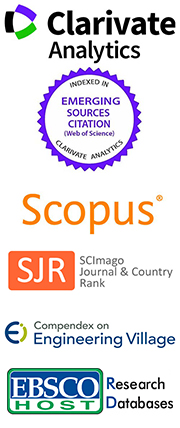Optimization of Drying Temperature Distribution using CFD and Experimental Methods for Cape Gooseberry Drying
Abstract
This study aims to enhance the drying quality of cape gooseberries by addressing the non-uniform temperature distribution typically observed in traditional drying processes. Computational Fluid Dynamics (CFD) was employed to redesign the drying chamber by integrating a centrally positioned baffle duct to improve airflow distribution. Various hot air inlet velocities were simulated to optimize temperature uniformity. The CFD results indicated that an optimal inlet velocity of 3–5 m/s maintaining a consistent drying temperature between 59–60°C. This condition was applied in the actual construction of the drying chamber. Validation experiments showed that CFD-predicted temperatures deviated by less than 10% from measured values across all monitoring points. This confirms the reliability of the CFD. Following the validation, further experiments were conducted to evaluate drying quality of cape gooseberries. Additional factors such as pretreatment duration, ripeness, and drying method were investigated to determine their influence on product quality. Pretreatment duration and ripeness significantly affected drying efficiency and physiochemical properties. A 3-day pretreatment resulted in lower post-drying moisture content (MC) compared to a 5-day treatment, while less ripe fruits (Grade C) demonstrated suboptimal drying quality. Moreover, drying method and ventilation control also played a critical role. The first method, fully opening vents during the initial 6 hours, produced lower average MC and water activity (Aw) than the second method, partially opened the vents.
Keywords
Full Text:
PDFReferences
Omolola A.O., Jideani A.I.O., and Kapila P.F., 2017. Quality properties of fruits as affected by drying operation. Critical Reviews in Food Science and Nutrition 57(1): 1-68.
Radojčin M., 2021. Review of effect of selected drying methods and emerging drying intensification technologies on the quality of dried fruit. Processes 9: 1 – 21.
Chua K.J., Hawlader M.N.A., Chou S.K., and Ho J.C., 2002. On the study of time-varying temperature drying—effect on drying kinetics and product quality. Drying Technology 20(8): 1559–1577.
López-Ortiz A., Rodríguez-Ramírez J., and Méndez-Lagunas L.L., 2013. Effects of drying air temperature on the structural properties of garlic evaluated during drying. International Journal of Food Properties 16(7): 1516–1529.
Putra R.N. and T.A. Ajiwiguna. 2017. Influence of air temperature and velocity for drying process. Procedia Engineering 170: 516–519.
Vásquez-Parra J.E., Ochoa-Martínez C.I., and Bustos-Parra M., 2013. Effect of chemical and physical pretreatments on the convective drying of cape gooseberry fruits (Physalis peruviana). Journal of Food Engineering 119(3): 648–654.
da Costa Ribeiro A.S., Aguiar-Oliveira E., and Maldonado R.R., 2016. Optimization of osmotic dehydration of pear followed by conventional drying and their sensory quality. LWT - Food Science and Technology 72: 407–415.
Önal B., Adiletta G., Crescitelli A., Di Matteo M., and Russo P., 2019. Optimization of hot air drying temperature combined with pre-treatment to improve physico-chemical and nutritional quality of ‘Annurca’ apple. Food and Bioproducts Processing 115: 87–99.
de Junqueira J.R., Corrêa J.L.G., de Oliveira H.M., Ivo Soares Avelar R., and Salles Pio L.A., 2017. Convective drying of cape gooseberry fruits: Effect of pretreatments on kinetics and quality parameters. LWT - Food Science and Technology 82: 404–410.
Gai Y., Zhang Z., and Wang X., 2024. The influence of various layouts of internal baffles on air distribution in heat pump cabinet dryers. International Communications in Heat and Mass Transfer 159: 1 – 17.
Wang D., Tan L., Yuan Y., and Liu R., 2025. Design and structure optimization of a new type drying material room based on the analysis of velocity uniformity and temperature distributions using CFD. J Mech Sci Technol 39(5): 2917–2928.
Dionissios P., 2006. Dried product quality improvement by air flow manipulation in tray dryers. Journal of Food Engineering 75: 542–550.
Amanlou Y., 2010. Applying CFD for designing a new fruit cabinet dryer. Journal of Food Engineering 101: 8 – 15.
Suhaimi M., 2013. The CFD simulation of tray dryer design for kenaf core drying. Applied Mechanics and Materials 393: 717 – 722.
Carrera Escobedo J.L., 2018. Computational fluid dynamics analysis for improving temperature distribution in a chili dryer. Thermal Science 22(6): 2615 – 2623.
Natalia S., 2017. Drying uniformity analysis in a tray dryer: an experimental and simulation approach. Advance Journal of Food Science and Technology 15(SPL): 233 – 238.
Dechpratoom C. and K. Wuttikid, 2023. Numerical simulation and experimental study of thermal distribution behavior in downdraft ceramic kiln. Journal Of Technical Education Science 78B: 36 – 44.
DOI: https://doi.org/10.64289/iej.25.03A11.4159859


